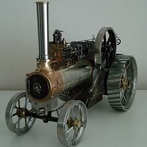Leaderboard
Popular Content
Showing content with the highest reputation on 06/08/2019 in all areas
-
1 pointA bit more progress on the 900 today by rebuilding the steering. A video update
-
1 point

A Mystery Roaring Twenties Refurb.......hopefully!
nigel reacted to Anglo Traction for a post in a topic
Thanks, and yes I did briefly mention the condenser situation in post #14 on page one. I agree with you on the later canister (m1750 type) versions regarding their reliability/inconsistency. If this engine had that style, I would have replaced it irrespectively.. I don't have a pic of the back of the brass condenser/points box, but it is solidly filled. The condenser, being the original patented design of 1921 is constructed using Mica sheets in between the aluminium plates (according to the 2 Authors of the books I have). On this version, the whole unit is fitted into the box and then flooded with molten bitumen, so it's hermetically sealed within. Modern Villiers condensers (mid 30s onwards-ish) were constructed using waxed paper as an interleaved insulator and these have a tendency to break down quicker (as per the books). I decided to give the original one the opportunity to prove itself in it's quality/reliability based on the condition of the original points faces (platinum), where there was only the slightest sign of 'arc pitting' (coil/condenser side) and tiny peak on the earth/ground side, which could indicate a possible slight over capacitance when it was last running. There are statements in the books that say these old versions rarely fail . I'll know where to look if a problem shows up. The progressive condition of the spark was consistent using several spark plugs (non resistor). So with a few backups, I'm going to run it initially on the original plug (Champion 8 com). The worn Points Heel was likely to be a possible problem, but on assembly, the clearance/lift was way more than enough to set the points gap . Thanks Norm. For the few revs it's done so far, it seems to have a bit of a 'bark' to the exhaust note. I'm expecting this to run at around 1500-1750 rpm, so a sound like the old vintage Bikes of the age and a bit noisier . -
1 point

A Mystery Roaring Twenties Refurb.......hopefully!
nigel reacted to Anglo Traction for a post in a topic
A bit more than I could deal with without finding more large tooling like bending rolls and a larger welder Norm. A long search for the correct size may be the only way. I reckon sorting the mower will be quicker. Not sure if it was worth the wait for people, but hope it is seen for what it's worth. An overdue update which has established the drive chain dilemma and now has at least linked the Counter Shaft to the engine, so it can be turned over with the handle. Also, I mentioned I was not happy with the badly worn split bushing that holds the Armature plate on the engine's crankshaft bushing. Marathon job for me, machining it from 40mm solid EN8 bar. Pressed out the old one- Careful measuring so the new one fits as well as the old one and the bore finished undersize (0.9970") to fit the crank bushing with an interference fit- Loads of swarf later, moved it to the Mill still in the chuck to put the first slit in- Could not see why the slit needed to be as wide as the original, so kept it 1/32" (.8mm) and back on the Lathe for parting off- I could then fit it in a machine vise for the second slit and pressed it back into the plate- I bottled out in the end and replaced the HT Coil - Points wire just to be sure, so was now confident that it was as good as I could get it Mag- wise. The Armature Plate went back onto the engine as planned, a good interference fit with zero movement on the bushing before tightening the securing screw. Final check/clean and the flywheel replaced to set the points gap and timing and the anxiety was building. I knew the magnets were reasonable and had 'Keepers' fitted while work was done. So had no excuses left and started to check for a spark. First few cranks of the handle produced nothing, then next turns, spotted a few faint, inconsistent sparks. I knew the mag needed to be re-energised and could take a while. That was last week. Today, I set to it again and more cranking and checking. Finally, the sparks were more consistent and brighter, but not sure if strong enough. Went for it and primed the cylinder with some petroil, shoved the original Spark plug in. Cranked it up with the De-comp open, then closed it and it fired up briefly !!!. So after over 80 years, the old Villiers has a pulse and a brief mechanical heartbeat. Next week, I'll hope to run it for longer and get some heat into it. It will be a while before I can run/drive it....nothing to hook it up to yet. -
1 point

A Mystery Roaring Twenties Refurb.......hopefully!
nigel reacted to Anglo Traction for a post in a topic
I am inclined to agree about it's appearance Norm. I feel it has that simple 'Bolty' look about it. Plus the combination of the colours and bright parts. I've been struggling with progress, as I hit a wall trying to obtain some drive chain which is only used on a few vintage machines and motorcycles. Zero response from two attempts over the last week, then tried another this afternoon where I got an almost immediate and positive reply. So I'm over my last hurdle of finding parts hopefully, but I think I will have to make another obsolete part for the engine, not happy yet?. Have made a little progress and assembled the Clutch/cable/lever, but had a problem with the lock screw gripping the cable tight enough in the lever. Lot of tension in the clutch spring to overcome, so I've made a temporary lockscrew with a socket head to be able to tighten it better- - Decided on the fuel pipe routing, keeping it within the frame and shortest distance. Original route can be seen in the 'as found' pics. Just the Carb end to fix and solder, as this pic was taken when a trial fit was made, the coil position etc is now tidier - As for finding a mower to attach it to, well it did come with the original mower it used to push back in the 1920s and here is a pic of how it attaches- One or two examples can be seen around the show circuits affixed to a mower, or like this example (off the Web) where an axle from a different machine has been adapted to fit- Would be nice to find a set of similar wheels to make an axle up for this one I'm working on. When it's fitted to a mower, the turning circle is enormous. Looking forward to chain delivery. -
1 point

A Mystery Roaring Twenties Refurb.......hopefully!
nigel reacted to Anglo Traction for a post in a topic
Well, those of you who have been watching this have seen glimpses of bits that don't really mean much. So I have decided to let you know what this thing is, despite having a fair way to go before (if) any mechanical life can be breathed into it. It's 90% there, but still have the drive chain hurdle to overcome. So bearing in mind that it's nothing really spectacular, it is uncommon. This is what it is - This ad is from the Tatler Magazine of Aug 1922. I have other images, but are copyrighted and not for public use. Designed to provide assisted (Ride-on) power to existing, manually pushed lawnmowers at the time. So it can be called the first known British Ride-on that was available to the average domestic household. Earlier large private Estate/Municiple ride-ons were available. They were built by Ransomes, Sims & Jefferies for the MP Co. At the start of this Topic, I mentioned the condition and it's neglected existence, albeit virtually complete. This is what it looked like- Not my pics, but shows it was in a bad state. It's debatable whether to replace some damaged/missing parts like the (left) lower end section of the Fan cover- I suppose it is really part of it's existence, hard knocks 'n' all. What I have found strange, is the varying immunity of certain sections to corrosion. Some very thin metal sheet parts are hardly eroded, but heavier, thicker spring steels are heavily pitted?. All exposed to the same levels of weather. Suppose it's lucky to be able to save/use most of it. Today, I've made up the Cables for Carb controls. Tricky job and I decided to set it up in a way that would be easier to manage. Bolted the Carb to my Lathe tail stock barrel and the Levers to a bar in the Chuck- The inner cables were different length from a donor source and I had make them both the same length and produce new outer bowden cables. Lots of careful measuring, as the 1926 Carb manual says never dismantle the Lever and cables !!. I had no choice. So with a lot of cleaning to get the solder to take on the shortened inner cable, all the ends soldered up and the bits fitted correctly- And relieved to say everything operates/adjusts correctly - Most of the control levers were in a bad state as mentioned way back and showed the end result, but here are a few of what they were like- ...... the Counter shaft - So here is what it looked like as assembly progressed- And to date- If I can get it running, it will be one of only a handful of working examples in collector's hands. Hope to have more updates soon

